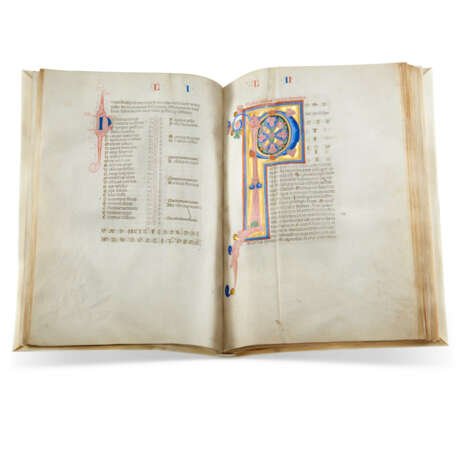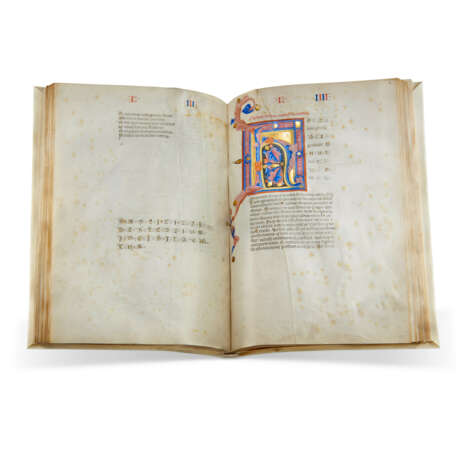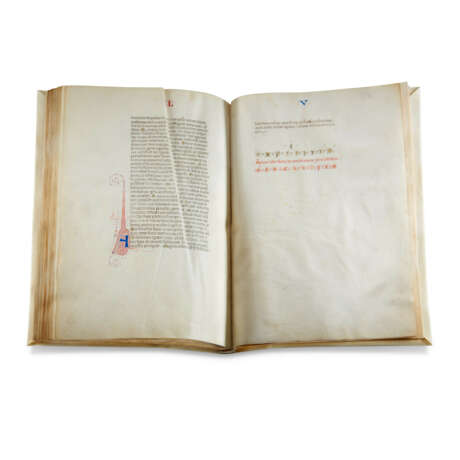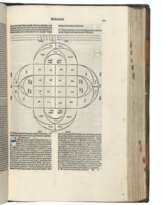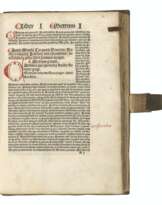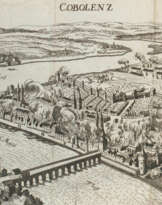ID 993185
Lot 39 | Boethius (c.476-524)
Valeur estimée
£ 30 000 – 50 000
De Consolatione Philosophiae, in Latin, illuminated manuscript on vellum [Florence, c.1400]
A sumptuously illuminated Florentine copy of one of the last great Western work of the Classical period. Its sister manuscript is now at Northwestern University.
273 x 193mm. ii + 66 + ii leaves, complete, 1-78, 810, 33 lines written in a gothica textualis, ruled space: 147 x 90mm., catchwords survive, headings in red and blue, rubrics in red, explicits of Books in elaborate calligraphic script touched in yellow, three-line-high penwork initials throughout alternating red and blue with flourishes extending into margins, 5 large illuminated foliate initials at the beginning of each book (a few wormholes and light marginal staining, else with wide, fresh margins and in fine condition). Bound in modern limp vellum with white leather ties, gilt edges. Fitted red cloth box.
Provenance:
(1) Joseph Sams (1776?-1860), of Darlington, antiquarian bookseller, A Descriptive Catalogue of a Valuable Collection of Books in Various Languages, 1822, lot 6293. The catalogue note states it ‘was recently purchased at Florence’. From this earliest published provenance to when it was purchased for the Art Institute of Chicago in 1915, our Boethius was bound with a manuscript of Horace: by the time De Ricci described it in 1935 (S. De Ricci, Census, I, p.515), the Horace was no longer there. We have identified Chicago, Northwestern University, McCormick Library, L Manuscript 14 as the lost Horace manuscript: format, illumination, scribe, number of lines and leaves all match.
(2) John Broadley, F.S.A. (1774-1833): his sale, Evans, 12 July 1832, lot 344.
(3) David Stewart Ker (1816-1878), Irish landowner of Montalto and Portavo: his sale at Christie’s, 1 February 1848, lot 785, to Rudd.
(4) Samuel Weller Singer (1783-1858), English author and Shakespeare scholar: his monogram ‘SWS MDCCCXVIII’ in red and blue ink dated 1818 in the upper right corner of f.1. De Ricci erroneously suggested that the ‘W’ was William Young Ottley. Sold at the Singer sale Catalogue of a select collection of autograph letters, many important manuscripts […] the property of S.W. Singer, Esq. F.S.A., Sotheby’s, 3 August 1858, lot 129. In this and subsequent sales the manuscript was described as being bound in a Renaissance-style binding with gilt edges by F. Bedford.
(5) Henry Huth (1815-1878), English merchant banker and bibliophile: no. 1401 in Quaritch’s A short handlist of the rarer & most important books in the Huth Library (February 1911), and finally the Huth sale, Catalogue of the famous library of printed books, illuminated manuscripts, autograph letters and engravings collected by Henry Huth, and since maintained and augmented by his son, Alfred H. Huth, Sotheby’s, 15 November 1911, lot 809 (illustrated).
(6) J. & J. Leighton, Catalogue of manuscripts mostly illuminated, many in fine bindings, (1912), no. 40. Bought by:
(7) Wilfrid Voynich (1865-1930), Polish revolutionary, antiquarian and bibliophile remembered as the eponym of the celebrated Voynich manuscript at the Beinecke. Purchased in 1915 for the Art Institute of Chicago by Mrs. John J. Borland following Voynich’s exhibition at the Art Institute, 7 October – 3 November 1915 (see ‘The Voynich Collection’, in Bulletin of the Art Institute of Chicago, vol IX, 1915, pp. 97-100, where this manuscript is described as follows: ‘a Florentine manuscript of Horace’s Art of Poetry and Letters written and illuminated on fine Roman vellum about 1360’.)
Content: Boethius, De Consolatione Philosophiae, I-V ff.1-66, beginning ‘Anitii Mallii Severeni Boetii de consolatione phylosophyca liber primus incipit. Prefatio sive proemium ad totum opus accommodatum &c. / Carmina qui quondam studio florenti peregi […]’: Book I f.1; Book II f.10; Book III f.22; Book IV f.40; Book V f.55.
The Consolation of Philosophy was written by Boethius during the imprisonment that immediately preceded his death. It takes the form of a dialogue between the author and Lady Philosophy, who comes to console him by reminding him of the suffering of other thinkers, of the vagaries of Fortune and of the vanity of worldly values. The five books are interspersed with 39 short poems and the work is the basis of Boethius’ literary reputation. It was widely translated, its translators including Alfred the Great, Chaucer and Elizabeth I, and it provided comfort to readers throughout the Middle Ages. In spite of its importance and popularity the work is not common at auction: this is only the second complete copy of the Latin original to have been offered at public auction in the last 50 years (the last complete – unilluminated – manuscript was sold at Christie’s, 8 June 2005, lot 23). The illumination in the Art Institute manuscript puts it in a different category altogether.
Illumination:
The elaborately geometrical, foliate illuminated initials with their palette of dark reds and blues, bottle greens and dull pinks point to the manuscript having been decorated in Florence at the turn of the 15th century, and specifically within the sphere of the most renowned site of manuscript production at the time: the Camaldolese house of Sta Maria degli Angeli, home of Don Simone Camaldolese and Don Silvestro dei Gherarducci.
The illuminated initials are on ff.1, 10, 22, 40, and 55.
Special notice
No VAT is payable on the hammer price or the buyer's premium for this lot. Please see the VAT Symbols and Explanation section of the Conditions of Sale for further information
| Artiste: | Boèce (480 - 524) |
|---|---|
| Lieu d'origine: | Italie, Europe |
| Catégorie maison de vente aux enchères: | Manuscrits médiévaux et de la Renaissance |
| Artiste: | Boèce (480 - 524) |
|---|---|
| Lieu d'origine: | Italie, Europe |
| Catégorie maison de vente aux enchères: | Manuscrits médiévaux et de la Renaissance |
| Adresse de l'enchère |
CHRISTIE'S 8 King Street, St. James's SW1Y 6QT London Royaume-Uni | |
|---|---|---|
| Aperçu |
| |
| Téléphone | +44 (0)20 7839 9060 | |
| Commission | see on Website | |
| Conditions d'utilisation | Conditions d'utilisation |
